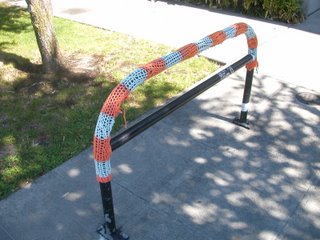Seen On The Streets of Seattle: Notes on Graffiti Knitting
Knitta is a Houston-based group of knitting graffiti artists. I saw this piece at the Frye Art Museum in Seattle after seeing an interesting exhibit of Henry Darger's Vivian Girls drawings, and had a few thoughts on it.

The pieces seem to be generally made for standard-sized objects like this guardrail - they also make sleeves for car antennas, scarves for light poles, and hats for fire hydrants. The pieces are knitted in advance and zip-tied to their host objects.
On the simplest level, the artists are playing with the tension between the domestic connotations of knitting and the public perception of graffiti as an antisocial and radical act, and this may be the group's main purpose. The Stranger (a Seattle weekly, which I used to freelance for when I lived in Seattle) wrote a straightforward piece about Knitta's visit and basically took this position.
Personally, I think this work is a direct descendent of the '90s soft-punk movements (Riotgrrl, emo) and the subsequent '00s punk-craft movement, and in this sense is actually quite unsubversive - especially against the backdrop of a city like Seattle, which, along with Olympia, Portland, and the rest of the Northwest, gave birth to most of the above. For the casual viewer, it does not seem obvious that this should be compared to graffiti, and thus really challenges no one's assumptions. Ironically, their ingratiating and playful form exclude them from the class of objects they hope to parody, comment on, or contribute to, as far as the "audience" of non-graffiti-thinking folks is concerned, which is why I think the Stranger's view misses the point here.
The works are a little more subversive seen from the perspective of graffiti writers and their fans. Knitta's practices violate one guideline of the medium and highlights another in an interesting light.
In terms of contrasts, almost all graffiti is created on-site, and in that sense is both site-specific and a story of its own creation. Knitta's works, while carefully hand-crafted using methods that involve great skill (like good graffiti writing), are not created on-site and appear to be created as a stockpile of materials to be applied to found surfaces and objects. In this sense, Knitta's work is similar to the wheatpaste graffiti art movement, which uses pre-printed posters cut into the shapes of drawn creations, and which have faced challenges by some in the graffiti writing community as thus not qualifying as true graffiti writing, but as simple "tags" - marks that someone has been there and made their mark, but not in a thoughtful way. One argument has been that they do not demonstrate comparable skills, but I think it is equally important to recognize that most of them are not inspired by, that is, drawn out of, a space, but are applied to a space that meets the artwork's preestablished criteria. (Some of the best wheatpaste graffiti works are an exception to this rule, and are clearly site-specific.) In this sense, Knitta pieces suggest some of the strengths of each of these graffiti formats while being very different from each of them.
Wheatpastes also lack some of the excitement of painted graffiti writing because they are relatively quick to put up. A graffiti mural shows off the artist's willingness to take a substantial risk by hanging out somewhere and creating something complex in an illicit context. A wheatpaste takes as long to put up as a poster.
But knitted graffiti speaks to the medium in its acknowledgment of the fragility and short-lived nature of graffiti artworks. Murals are painted in depressed or inaccessible locations in hopes of lasting a while, but with the full knowledge that they might be painted over the next day. A viewer does not see this, however, and without a familiarity with this context the piece may suggest a permanence that it does not enjoy. Knitta's works, however, feel fragile and very temporary. They capture for a casual viewer something of the privilege of spotting something worth looking at, which clearly might not be there tomorrow or the next day. Anyone could come along with a pair of scissors and remove it.
The Stranger also reports that Knitta will be back in Seattle for the music fest Bumbershoot 2oo6:
Along with Knitta—who will be hitting some very big (think landmark-sized) Seattle targets on their Labor Day return—artists like Australia's Brett Alexander, London's Craig Fisher, and New Yorker Orly Cogan will confront preconceptions about the applied arts, via everything from subversive candy making to soft-sculpture weaponry. And on the evening of Saturday, September 2, the Knitta crew will host a workshop. The plan is to offer instructions for making some of their basic tags, like car antennae sleeves.I look forward to seeing some Christo-like knitted objects, but again, I bet it won't look like graffiti to casual viewers. Knitta, prove me wrong!








No comments:
Post a Comment